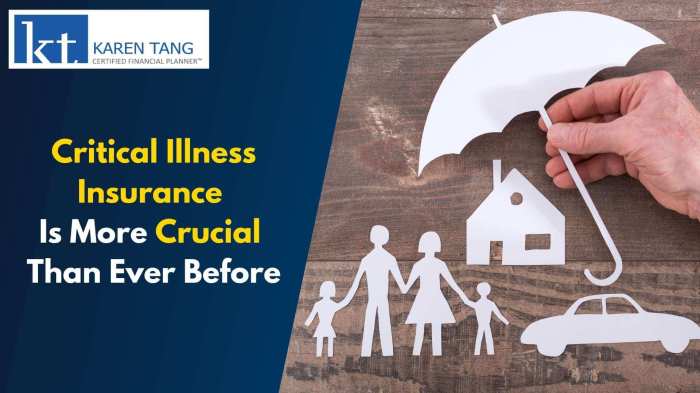Critical illness insurance provides a vital financial safety net when faced with a serious diagnosis. However, the specific diseases covered can vary significantly between policies. Navigating the complexities of these policies to ensure adequate protection is crucial. This comprehensive guide will help you understand how to choose a critical illness insurance plan that covers the diseases most relevant to your individual needs in 2025 and beyond.
Understanding Critical Illness Insurance Coverage
Critical illness insurance differs from health insurance. While health insurance covers medical expenses, critical illness insurance provides a lump-sum payment upon diagnosis of a specified critical illness. This payout can help cover medical bills not covered by health insurance, lost income, rehabilitation costs, and other expenses associated with a serious illness. The key is to choose a policy with comprehensive coverage tailored to your risk profile.

Source: karentang.sg
Key Considerations When Choosing a Policy
- List of Covered Illnesses: Carefully review the policy document’s definition of covered illnesses. Some policies may only cover a limited number of conditions, while others offer more extensive coverage. Look for policies that include a wide range of cancers, heart conditions, strokes, and other major illnesses.
- Definition of “Critical Illness”: Pay close attention to the specific definitions used for each illness. Some policies may have stricter criteria for diagnosis, impacting your eligibility for a payout. For example, the stage of cancer or the severity of a heart condition might influence coverage.
- Waiting Periods: Most policies include a waiting period before coverage begins. Understand the duration of these waiting periods for different illnesses. Longer waiting periods can delay your access to benefits if you become ill shortly after purchasing the policy.
- Benefit Amount: Determine the appropriate benefit amount based on your individual circumstances and potential financial needs. Consider factors like medical expenses, lost income, and rehabilitation costs.
- Policy Renewability: Check whether the policy is renewable and under what conditions. Some policies may become more expensive to renew as you age.
- Early Diagnosis Benefit: Some policies offer additional benefits for early diagnosis of certain illnesses, providing financial support for prompt treatment.
- Multiple Claim Benefit: Inquire about the possibility of multiple claims. Some policies may allow multiple payouts for different illnesses during the policy term.
Emerging Diseases and Critical Illness Coverage
The medical landscape is constantly evolving. New diseases and treatments emerge, and it’s crucial to consider how your critical illness insurance policy addresses these developments. While specific future illnesses are impossible to predict, selecting a policy with broad coverage and a reputable insurer is essential. Look for policies that have a mechanism for reviewing and updating their covered illnesses over time.
Staying Ahead of the Curve: What to Look For
- Broad Definitions: Policies with broad definitions of covered illnesses are better equipped to handle emerging diseases or variations of existing ones. Avoid policies that list specific illnesses with very narrow definitions.
- Reputable Insurer: Choose a financially stable and reputable insurer with a history of adapting their policies to reflect advancements in medical science. Check their financial ratings and customer reviews.
- Policy Flexibility: Inquire about the insurer’s process for updating their list of covered illnesses. Some insurers may periodically review and revise their policies to incorporate new medical information.
- Technological Advancements: Consider policies that might address illnesses related to technological advancements, such as those stemming from artificial intelligence or nanotechnology in the future.
Specific Illnesses to Prioritize in Your Coverage
While every individual’s risk profile is unique, certain illnesses consistently rank among the most costly and debilitating. Prioritize policies that offer comprehensive coverage for these conditions:
High-Priority Illnesses for Critical Illness Coverage
- Various Cancers: Cancer treatment can be extremely expensive, and coverage for different types of cancer is vital. Ensure your policy covers a broad range of cancers, not just a few specific types.
- Heart Conditions: Heart attacks, strokes, and coronary artery disease are major causes of disability and death. Comprehensive coverage for various heart-related illnesses is essential.
- Major Organ Failure: Kidney failure, liver failure, and other major organ failures require extensive and costly treatment. Look for policies that explicitly cover these conditions.
- Neurological Disorders: Conditions like multiple sclerosis, Parkinson’s disease, and Alzheimer’s disease can significantly impact quality of life and require extensive long-term care.
- Specific Diseases with High Treatment Costs: Research the cost of treatment for specific diseases prevalent in your region or family history and ensure your policy covers them.
Choosing the Right Insurer and Policy
Selecting the right insurer and policy is a crucial step. Consider the following factors:
Factors to Consider When Choosing an Insurer
- Financial Stability: Check the insurer’s financial strength ratings from reputable agencies to ensure they can meet their obligations.
- Customer Service: Read reviews and testimonials to assess the insurer’s customer service reputation. A responsive and helpful insurer can make a significant difference during a difficult time.
- Claims Process: Understand the insurer’s claims process and how quickly they typically process claims. A streamlined claims process can ease financial burdens during a critical illness.
- Policy Transparency: Choose an insurer that provides clear and easy-to-understand policy documents.
Frequently Asked Questions (FAQ)
- Q: What is the difference between critical illness insurance and health insurance?
A: Health insurance covers medical expenses, while critical illness insurance provides a lump-sum payment upon diagnosis of a specified critical illness. - Q: How much critical illness insurance coverage do I need?
A: The amount of coverage depends on your individual circumstances, including potential medical expenses, lost income, and rehabilitation costs. - Q: Can I get critical illness insurance if I have a pre-existing condition?
A: It may be more difficult to obtain coverage or you might face higher premiums. It’s crucial to disclose all pre-existing conditions honestly. - Q: How do I file a claim under my critical illness insurance policy?
A: The claims process varies by insurer, but generally involves submitting medical documentation to support your claim. - Q: What happens if my critical illness is not listed in the policy?
A: You will not receive a payout unless the policy includes broader definitions that could encompass your illness.
Conclusion
Securing adequate critical illness insurance is a vital part of financial planning. By carefully considering the factors Artikeld in this guide, you can choose a policy that provides comprehensive coverage for the illnesses most relevant to you. Remember to prioritize policies with broad definitions, reputable insurers, and a clear claims process. Don’t hesitate to seek professional advice from a financial advisor to determine the best coverage for your individual needs.

Source: moneyadviceclinic.com
References
(Please note: Insert links to reputable sources such as insurance comparison websites, government health websites, and reputable financial planning organizations here. Examples would include websites of major insurance companies and relevant government health agencies in your target region.)
Call to Action
Ready to secure your financial future? Get a free quote today and compare critical illness insurance plans to find the perfect fit for your needs! [Link to insurance comparison website or quote request form]
FAQ Overview
What if my pre-existing condition isn’t covered?
Many policies have exclusions for pre-existing conditions. It’s crucial to disclose all relevant health information during the application process. Some policies may offer coverage after a waiting period.
How often should I review my critical illness insurance policy?
It’s recommended to review your policy annually or whenever there are significant changes in your health or financial circumstances.
Can I increase my coverage amount later?
The ability to increase coverage depends on the insurer and your health status at the time of the request. It’s often easier to increase coverage earlier in the policy’s term.
What is the difference between critical illness insurance and disability insurance?
Critical illness insurance pays a lump sum upon diagnosis of a specified critical illness, while disability insurance provides income replacement if you become unable to work due to illness or injury.
